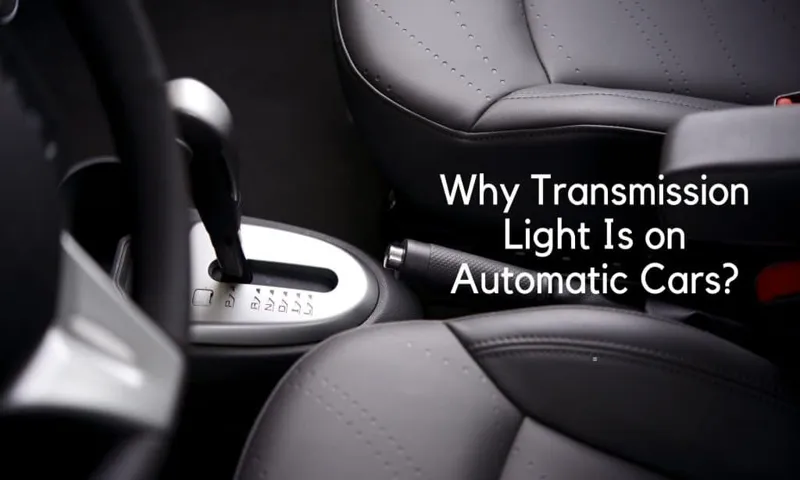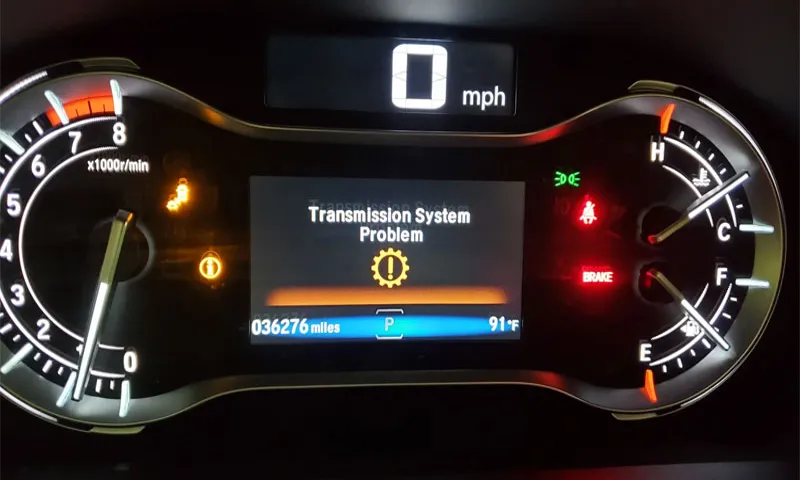When it comes to car trouble, seeing a dashboard light turn on can send any driver into a panic. But not all warning lights are created equal, and it can be tough to decipher what they mean if you’re not familiar with them. One common light that drivers might see is the transmission light, which can indicate a range of issues with your vehicle’s transmission system.
But what does the transmission light look like, exactly? In this article, we’ll take a closer look at this warning light and explore what it might mean if it appears on your dashboard. So buckle up and get ready to learn more about the mysteries behind the transmission light!
Table of Contents
Introduction
If you’re wondering what the transmission light looks like, it can vary depending on the make and model of your vehicle. Generally, the transmission light will look like a gear with an exclamation point inside it, or sometimes it may just say “transmission.” This light will usually illuminate on your dashboard if there is an issue with your transmission system.
It’s important to address any problems with your transmission as soon as possible, as neglecting these issues can cause further damage to your vehicle and potentially lead to costly repairs. If your transmission light appears, it’s best to bring your car in for a professional diagnosis as soon as possible. Overlooking these issues can lead to serious consequences down the line, so pay attention to your vehicle’s warning signals and seek help from a mechanic if needed.
Explanation of the Transmission Light
The transmission light is an essential component of modern vehicles and is designed to communicate important information to drivers about the vehicle’s transmission system. When the light comes on, it signifies a problem with the transmission system and requires immediate attention. The transmission light can be triggered by a range of issues, including low transmission fluid levels, overheating, or damaged sensors.
Ignoring the warning can result in significant damage to the vehicle’s transmission, leading to costly repair bills. It’s essential to understand what the transmission light means, and to take prompt action to diagnose and correct the issue. Neglecting the transmission light can result in more significant problems, which could prove costly to repair and potentially compromise the safety of you and your passengers.
It’s always best to address any issues with the transmission system as soon as they arise.

Types of Transmission Lights
When it comes to transmission lights, there are a few different types to be aware of. The most common type of transmission light is the dashboard warning light which can indicate anything from low fluid levels to a malfunctioning sensor. These lights can come in a variety of colors, but the most common is an amber or yellow color.
Additionally, some vehicles may also have a gear selection indicator light which can show which gear the vehicle is in. This can be useful for manual transmission vehicles or vehicles with a sport mode. It’s important to pay attention to these lights and seek out the appropriate repairs as needed to keep your vehicle functioning properly.
So, if you’re wondering what does the transmission light look like, it can vary, but it’s usually an amber or yellow warning light on the dashboard.
Dashboard Warning Light
Dashboard Warning Light If you’re driving a car with an automatic transmission, it’s important to understand the different types of transmission warning lights that may appear on your dashboard. The most common one is the “Transmission Temperature” warning light, which indicates that your transmission is overheating. This can be caused by towing heavy loads, driving in stop-and-go traffic, or driving on steep inclines.
Another common warning light is the “Check Engine” light, which indicates that there is a problem with your car’s engine or transmission. This could be caused by a range of issues, including a faulty sensor or a failed component within the transmission system. Finally, some cars have a “Transmission Fluid Level” warning light, which warns you when your car’s automatic transmission fluid is running low.
If this light comes on, it’s important to add transmission fluid as soon as possible to avoid further damage to your transmission. By keeping an eye out for these warning lights and being proactive about addressing any issues, you can help ensure that your car’s automatic transmission runs smoothly for years to come.
Overdrive Light
The overdrive light is just one type of transmission light that drivers may see on their dashboard. It typically indicates that the vehicle’s overdrive system is engaged, which can help improve fuel efficiency at higher speeds. However, there may be other transmission lights that can appear, depending on the make and model of the vehicle.
For example, some cars may have a transmission temperature light, which warns drivers if the transmission fluid is getting too hot. Other lights may indicate a problem with the transmission itself, such as a slipping clutch or faulty sensors. It’s important to pay attention to these lights and get any necessary repairs done promptly to avoid more serious (and expensive) transmission problems down the road.
Transmission Temperature Warning Light
Transmission Temperature Warning Light Transmission temperature warning lights are an important feature of any modern vehicle. They are designed to alert the driver when the temperature of the transmission fluid is too high. This type of warning light typically comes on when the transmission is being stressed beyond normal operating limits due to things like towing a heavy load, driving at high speeds for extended periods, or driving in heavy traffic in hot weather.
When the transmission fluid gets too hot, it can cause damage to internal components, leading to costly repairs. There are different types of transmission temperature warning lights, including a simple light that comes on to indicate that the transmission is overheating, or a more advanced system that provides a full diagnostic report of the transmission’s health and status. As a vehicle owner, it is important to understand the warning light system in your car and how to respond appropriately when it comes on.
Regular maintenance and servicing can also help to prevent transmission problems and keep your vehicle running smoothly.
Possible Causes of Transmission Light
If you’re wondering what the transmission light looks like, it usually appears as a warning symbol on your dashboard that resembles a gear with an exclamation mark. This light might indicate an issue with your vehicle’s transmission, such as low fluid levels, a malfunctioning sensor, or a damaged transmission component. Ignoring this warning light could lead to costly repairs, reduced fuel efficiency, or even complete transmission failure.
It’s essential to have your vehicle inspected by a professional mechanic as soon as possible if you notice this light, to prevent further damage and ensure your safety on the road. In some cases, a transmission light might also be accompanied by other symptoms, such as unusual sounds or vibrations, or difficulty shifting gears. Paying attention to these signs and acting quickly can save you money and prevent more significant problems in the future.
Low Transmission Fluid
If you notice the transmission light on your dashboard, one possible cause could be low transmission fluid. This could occur due to a leak in the system or simply because the fluid hasn’t been replaced in a while. Ignoring this issue could lead to serious transmission problems down the line, so it’s essential to address it as soon as possible.
If you’re not sure whether it’s the transmission fluid causing the issue, check for other symptoms like a noticeable decrease in performance or strange noises while driving. Don’t put off addressing this issue, as it could lead to costly repairs later on. Stay ahead of the game by regularly checking your transmission fluid levels and addressing any issues that come up.
This way, you can prevent any serious issues from arising and ensure that your vehicle keeps running smoothly.
Electrical Issues
Electrical Issues If your transmission light suddenly comes on, it could be indicative of a variety of issues. Most commonly, it can be caused by electrical problems within your vehicle. One potential cause is a faulty solenoid, which can prevent fluid from flowing properly and cause the transmission to shift erratically.
Another possible issue could be a sensor malfunction, such as a faulty speed sensor or throttle position sensor. These sensors help the engine control unit (ECU) monitor how your vehicle is functioning, and any errors can cause the transmission to send incorrect signals to the rest of the vehicle. It’s important to address these issues as soon as possible, as ignoring them could lead to costly repairs down the line.
If you suspect an electrical problem is causing your transmission light to come on, it’s worth consulting with a professional mechanic to identify and address the issue.
Transmission Malfunction
If you notice your vehicle’s transmission light come on, it can be alarming, and rightfully so! A transmission malfunction can range from a minor issue to a significant costly repair. So, what causes the transmission light to come on? There could be several reasons. A common reason is low transmission fluid levels.
This could happen due to a leak or normal wear and tear. Another possible cause could be a damaged sensor, which can affect the transmission’s performance and trigger the light. Electrical issues, mechanical failures, and clogged filters can also cause the transmission light to come on.
It’s essential to address this issue promptly to avoid further damage and costly repairs. If you’re uncertain about the cause for the warning light, it’s best to have a professional mechanic diagnose your car’s transmission issue and provide the necessary repairs. Remember, regular maintenance and inspections can help prevent unplanned repairs and ensure that your car runs smoothly on the road.
What to Do When the Transmission Light Comes On?
If you’re driving and notice the transmission light come on, it can be a worrying experience. The transmission light looks like a gear with an exclamation point in the middle. When this light appears, it means that your vehicle’s computer has detected an issue with the transmission system.
There could be a myriad of reasons why this can happen, so it’s best to take your car to a mechanic as soon as possible to determine what is causing the problem. Some common reasons for the transmission light to come on include low transmission fluid, a faulty transmission sensor, or a problem with the solenoid. Ignoring the warning can lead to more costly repairs in the future, so it’s best to have it checked out as soon as possible.
Conclusion
In the end, the transmission light is like a beacon of hope or a warning sign, depending on how you look at it. It can resemble everything from a simple exclamation point to a complex network of gears and arrows, but its true meaning is clear: pay attention to your vehicle’s transmission system or risk getting stuck in neutral. So, let the transmission light guide you towards a smooth ride and away from a bumpy road ahead.
“
FAQs
What is the purpose of the transmission light?
The transmission light indicates issues with the transmission system in your vehicle.
How does the transmission light look like?
The appearance of the transmission light may differ between vehicles, but it’s typically shaped like a gear or a wrench, and may be yellow or red.
Why is my transmission light on?
The transmission light may be on due to a variety of issues, such as low transmission fluid, a malfunctioning sensor, or mechanical problems with the transmission.
Can I continue driving with the transmission light on?
It’s not recommended to drive with the transmission light on, as it may cause further damage to the transmission system. It’s best to have the issue checked and resolved by a professional mechanic.
How much does it cost to repair a transmission issue?
The cost of transmission repairs can vary depending on the specific issue and the make and model of your vehicle. It’s best to get a diagnosis from a mechanic before estimating the cost of repairs.
Is it possible to prevent transmission issues?
Routine maintenance, such as regular fluid changes and inspections, can help prevent transmission issues. It’s also important to avoid aggressive driving and overloading your vehicle.
Can an automatic transmission be manually shifted?
Some automatic transmissions have a manual shift mode, which allows the driver to manually control the gears. However, it’s important to check your vehicle’s manual to see if it has this feature and how to utilize it properly.



